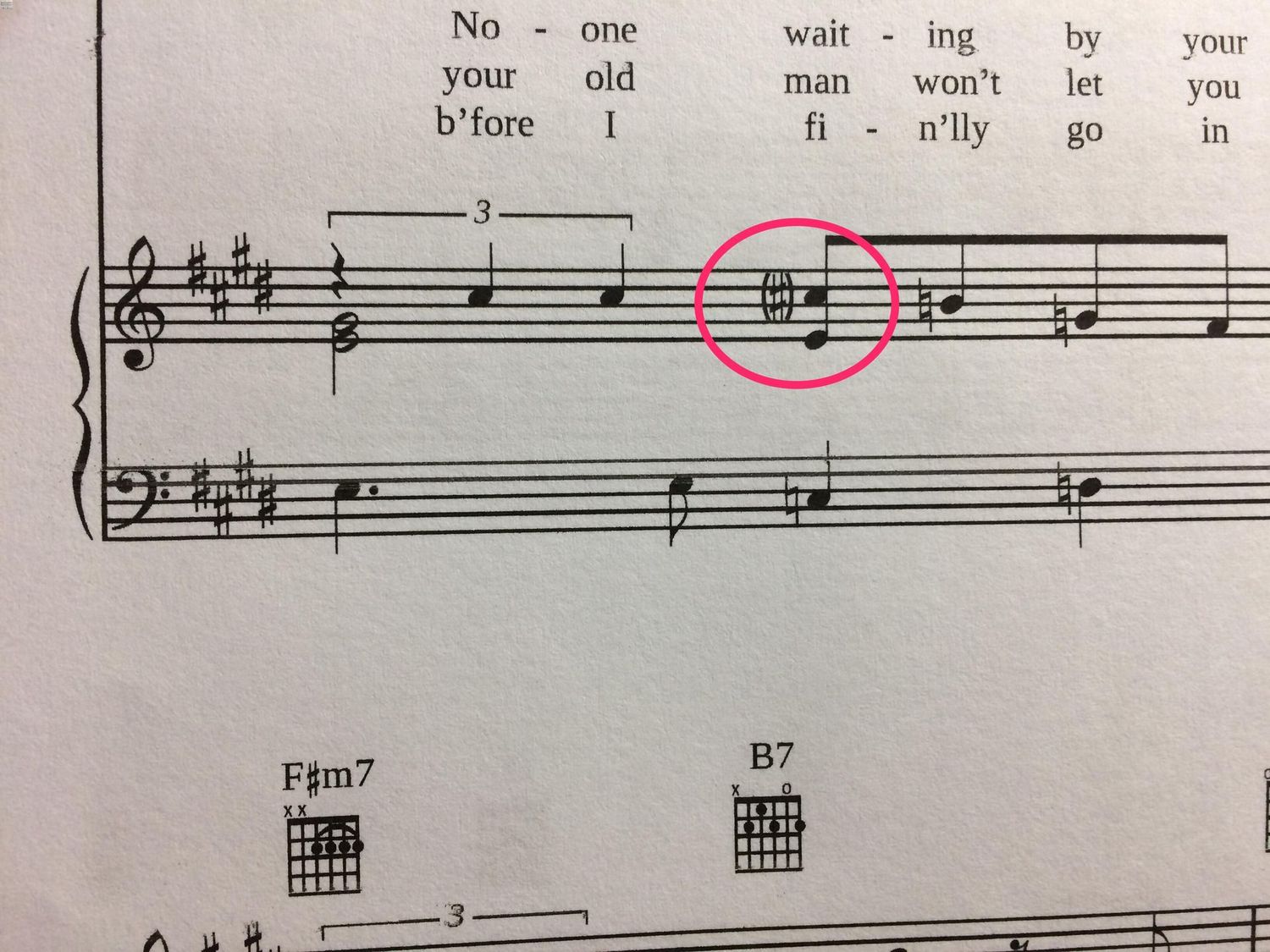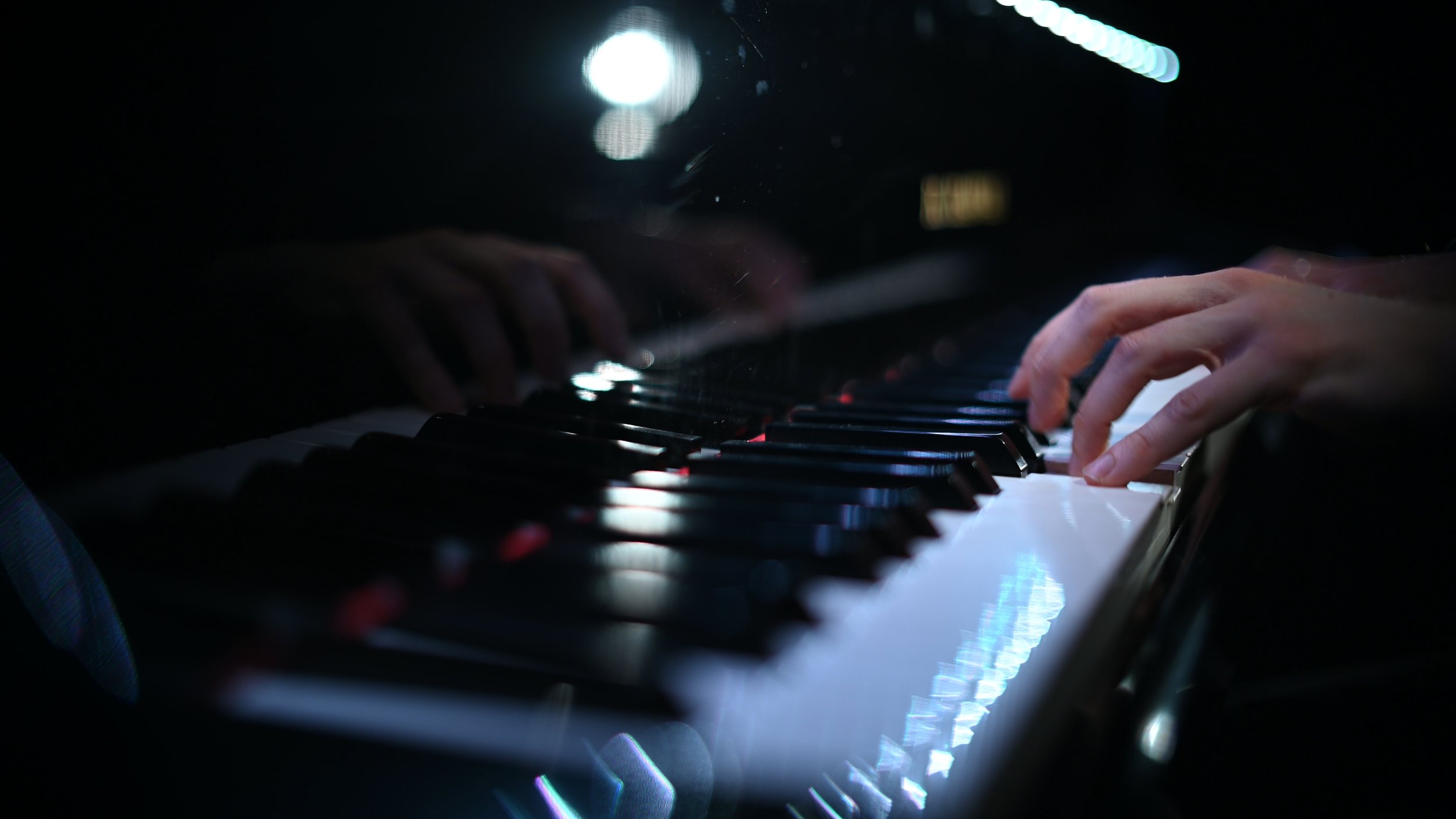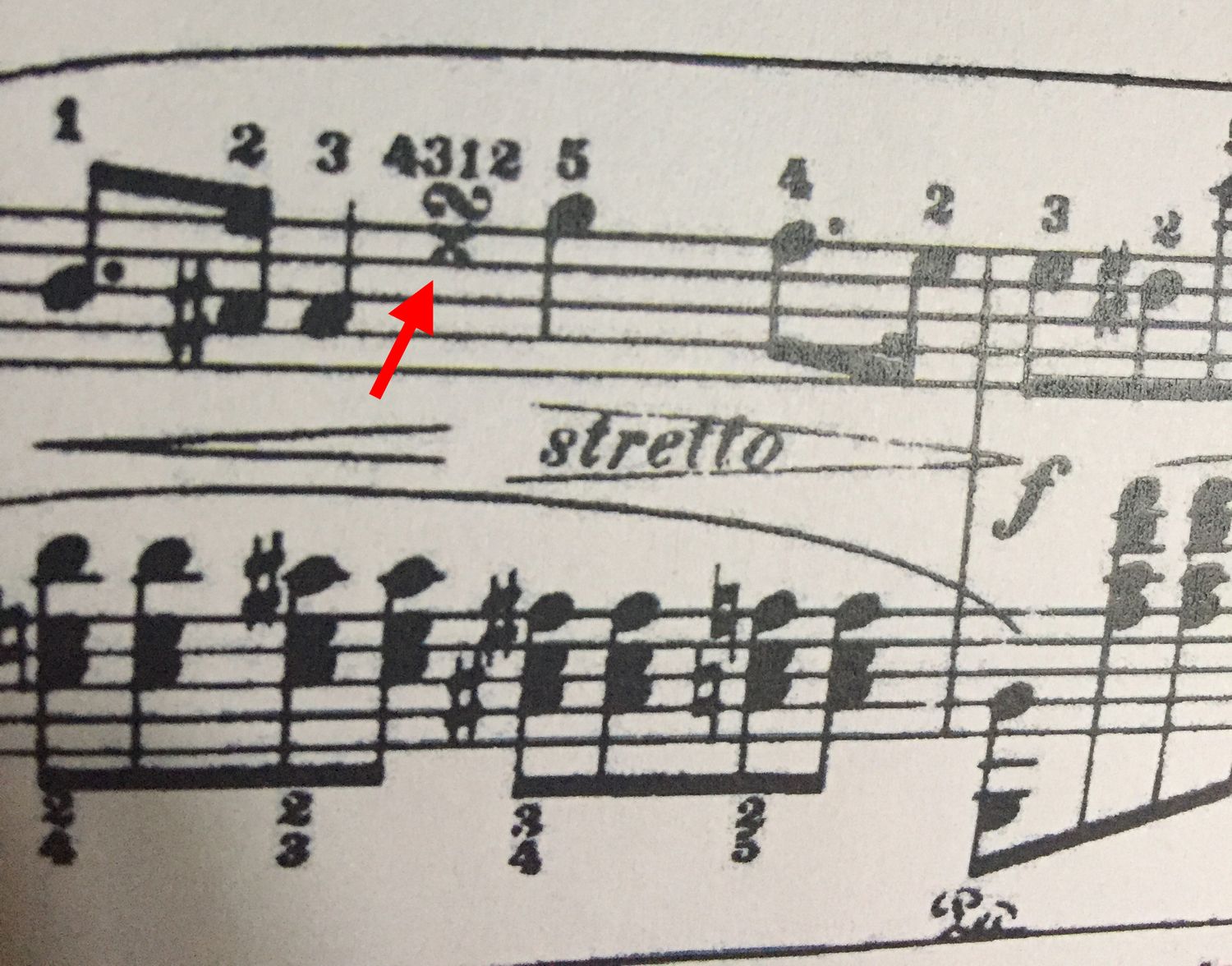Home>Events & Info>Note>What Does A Sharp Note Mean In Music


Note
What Does A Sharp Note Mean In Music
Modified: January 22, 2024
Discover the meaning of a sharp note in music and how it impacts melodies, chords, and key signatures. Enhance your understanding of musical notation with this comprehensive guide.
(Many of the links in this article redirect to a specific reviewed product. Your purchase of these products through affiliate links helps to generate commission for AudioLover.com, at no extra cost. Learn more)
Table of Contents
Introduction
Welcome to the fascinating world of music! Whether you’re a seasoned musician or just beginning your musical journey, understanding the fundamentals of music theory is crucial for your growth as an artist. One essential aspect of music theory is the concept of notes, which are the building blocks of melody and harmony.
Within the realm of notes, you may have come across terms like “sharp notes.” But what exactly does this mean? In this article, we will explore the concept of sharp notes in music, their identification, purpose, and usage.
At its core, music is a universal language that has the power to evoke emotions, tell stories, and connect people from all walks of life. Notes serve as the individual sounds within music, similar to the letters that form words in language. Understanding different types of notes, such as sharp notes, opens up a vast world of musical possibilities.
So, what exactly is a sharp note? How can you identify it in a musical composition? And what purpose does it serve? Let’s delve into the fascinating world of sharp notes in music and unravel their significance.
Definition: Sharp Note
A sharp note is a type of musical note that is raised by one semitone, or half step, higher than the natural note. It is denoted by the symbol “#” placed before the note name. When a note is “sharped,” it means that its pitch is increased slightly, resulting in a higher tone.
For example, let’s consider the note C. When we apply a sharp to it, it becomes C#. Similarly, if we take the note D and sharp it, it becomes D#. This pattern continues for all the natural notes in the musical alphabet, giving rise to their sharp counterparts.
It’s important to note that the concept of sharp notes applies to both the white keys and black keys on a standard piano keyboard. Each natural note can be sharped, except for B and E, which have black keys adjacent to them.
Sharp notes effectively increase the pitch and add a sense of tension or excitement to the music. They can be found in various musical genres, from classical compositions to pop, jazz, and everything in between.
It’s worth mentioning that a sharp note can also be represented by its enharmonic equivalent, which is a note that sounds the same but is written differently. For example, C# is enharmonically equivalent to Db. While they may have different names, they produce the same pitch.
How to Identify a Sharp Note
Identifying a sharp note in music might seem challenging at first, but with some practice and understanding, it becomes second nature. Here are a few methods to help you identify sharp notes in a musical composition:
1. Look for the “#” symbol: The most straightforward way to identify a sharp note is by looking for the “#” symbol placed before the note name. For example, if you see the note F#, it means that F has been sharped.
2. Observe the pitch alteration: Another way to identify a sharp note is by listening to the pitch alteration in the music. Sharp notes have a slightly higher pitch compared to their natural counterparts. By comparing the sound to the adjacent notes, you can easily recognize the presence of a sharp note.
3. Pay attention to the key signature: In many cases, sharp notes are notated in the key signature. Key signatures are placed at the beginning of a musical piece and indicate which notes are consistently sharped throughout the composition. For example, if the key signature has a sharp symbol next to the letter F, it means that every occurrence of F in the piece should be played as F#.
4. Consider the context and musical patterns: Sometimes, identifying a sharp note requires looking at the overall context of the composition and recognizing common musical patterns. For example, in a particular musical scale, if you see a pattern where certain notes are consistently raised by a semitone, those are sharp notes.
5. Consult sheet music or notation: If you have access to sheet music or notation, the sharp notes are typically indicated by the use of the “#” symbol or through the key signature. Following the written music can help you accurately identify and play the sharp notes.
Remember, identifying sharp notes will become easier with practice and exposure to different musical compositions. Keep a keen ear and stay attentive to the musical nuances, and soon, you’ll be able to identify sharp notes effortlessly.
Purpose of Sharp Notes in Music
Sharp notes play a crucial role in music, adding variety, complexity, and depth to compositions. Here are some of the key purposes of sharp notes:
1. Introduce Melodic Variations: Sharp notes are often used to introduce melodic variations within a piece. By raising the pitch of a note, composers can create intricate melodies and add a touch of unpredictability to captivate the listeners.
2. Enhance Harmonic Progressions: In harmony, sharp notes can be utilized to enhance chord progressions and create tension and resolution. By incorporating sharp notes in chord voicings, musicians can add richness and color to the overall sound, adding complexity and a dynamic element to the music.
3. Create Key Changes: Sharp notes are essential in modulations and key changes. When transitioning from one musical key to another, sharp notes are often utilized to smoothly transition and establish the new tonal center. This allows composers and musicians to explore different tonalities and create interesting musical journeys.
4. Express Different Musical Emotions: Sharp notes can evoke different emotions and moods in music. Depending on the context, a sharp note can add brightness, tension, or excitement to a composition. The deliberate and strategic use of sharp notes allows composers to convey specific emotions and convey their musical intentions to the audience.
5. Complement Other Musical Elements: Sharp notes work in harmony with other musical elements such as rhythm, dynamics, and timbre. They can complement intricate rhythmic patterns, accentuate powerful musical moments, and interact with various instruments to create a cohesive and compelling musical experience.
6. Expand Musical Possibilities: The inclusion of sharp notes expands the melodic and harmonic possibilities in music. It opens up a broader range of musical scales, modes, and intervals, allowing musicians to explore unique and unconventional sounds. Sharp notes contribute to the diversity and richness of musical compositions across genres.
Overall, the purpose of sharp notes in music is to add depth, complexity, and artistic expression to compositions. They serve as an essential tool for composers and musicians, enabling them to create captivating melodies, interesting harmonies, and evoke a wide range of emotions through their musical creations.
Usage of Sharp Notes in Different Musical Scales
Sharp notes play a significant role in various musical scales, contributing to their unique patterns and characteristics. Let’s explore some common scales and their usage of sharp notes:
1. Major Scale: The major scale is one of the most fundamental and widely used scales in music. In its standard form, the major scale follows a pattern of whole steps and half steps. The use of sharp notes in the major scale occurs when moving from the 4th to the 5th degree and the 7th to the 1st degree. For example, in the key of C major, the F note is sharp (F#) and the C note is natural.
2. Minor Scale: The natural minor scale has a distinct pattern that includes half steps between the 2nd and 3rd degrees, as well as the 5th and 6th degrees. Sharp notes can be incorporated in the harmonic and melodic minor scales, which introduce variations to create unique sounds and resolve certain intervals. For instance, in the key of A minor, the G note is sharpened to G# in the harmonic minor scale.
3. Pentatonic Scale: The pentatonic scale is widely used in many genres, including blues, rock, and pop music. It consists of five notes, omitting the 4th and 7th degrees of the major scale. Sharp notes can be included in pentatonic scales to introduce a bluesy or exotic flavor. For example, in the key of E major pentatonic, the F# note is sharp.
4. Blues Scale: The blues scale is a variation of the pentatonic scale that includes the addition of a flat 5th degree known as the “blue note.” While not strictly a sharp note, the blue note is often represented as a sharp note in certain musical contexts. It adds a distinct flavor and characteristic bluesy sound. In the key of C blues, the F note can be sharp (F#) to create the blues scale.
5. Modal Scales: Modal scales, such as the Dorian, Mixolydian, and Lydian modes, can incorporate sharp notes to create unique tonalities. These scales are often used in jazz, fusion, and modal compositions to explore different harmonic and melodic possibilities. For example, in the Dorian mode of G major, the C note is sharp (C#).
These are just a few examples of the usage of sharp notes in different musical scales. Each scale has its own distinct character and usage of sharp notes, contributing to the rich tapestry of musical expression. Understanding and utilizing sharp notes in various scales opens up a wide range of melodic and harmonic possibilities for composers and musicians.
Notation and Symbolism of Sharp Notes
In music notation, sharp notes are represented by the “#” symbol placed before the note name. This symbol indicates that the note should be played or sung one semitone higher than the natural note. The “#” symbol can be seen next to the note on sheet music, written above or below the corresponding line or space on the staff.
Notation software and music editing programs also provide the option to insert a sharp symbol automatically when inputting musical notes. This makes it easier for composers, arrangers, and performers to accurately represent and interpret sharp notes in their compositions.
While the “#” symbol is the standard notation for sharp notes, there is another notation method called the “courtesy accidental.” This method involves placing a small natural sign (“♮”) beside a note that is notated as a sharp in the key signature but needs to be played as a natural. The courtesy accidental reminds the musician that the note should not be sharp but should be played as a natural in that specific instance.
The symbolism of sharp notes goes beyond the notation itself. In music theory, sharps are associated with tension, excitement, and forward motion. They introduce a slight edge or brightness to a composition, adding intricacy and complexity to the sound. The raising of a note’s pitch through a sharp symbol can create a sense of anticipation, leading to resolution or a release of energy.
Sharp notes can also be seen as modifiers that alter the natural state of a note. By raising the pitch, sharp notes bring a contrasting element to the music, contrasting with the stability of the natural notes. They contribute to the dynamic range and overall expressiveness of a piece, allowing for a more nuanced interpretation.
Furthermore, the symbolism of sharp notes extends to key signatures. Key signatures indicate the set of sharp or flat notes that consistently appear throughout a musical composition. The presence of sharp notes in a key signature dictates a particular tonality and sets the groundwork for the piece’s harmonic structure.
Overall, the notation and symbolism of sharp notes serve to enhance the music, guiding performers in accurately playing the intended pitches and conveying the desired emotions and complexities of the composition.
Importance of Sharp Notes in Key Signatures
In music, key signatures are invaluable tools that provide essential information about the tonality and structure of a composition. They are a collection of sharp or flat symbols placed at the beginning of a piece, indicating which notes are to be consistently raised or lowered throughout the entire composition. Sharp notes play a crucial role in key signatures, and their importance can be seen in several aspects:
Establishing the Tonal Center: Key signatures help establish the tonal center or the “home” note of a composition. When sharp notes are incorporated into a key signature, they indicate that the piece is in a specific tonal key. For instance, a key signature with a single sharp (F#) indicates that the composition is likely in the key of G major or E minor. By consistently using sharp notes in key signatures, composers create a consistent tonal orientation for the music.
Creating Harmonic Patterns: The presence of sharp notes in a key signature establishes a specific harmonic framework for a composition. These sharp notes determine the chords and progressions that harmonically support the melodic elements. Composers and performers rely on the information provided by the key signature to determine the appropriate chords and follow harmonic conventions when playing or interpreting a piece of music.
Guiding Melodic Choices: The inclusion of sharp notes in key signatures influences the melodic choices made within a composition. The raised pitches provided by sharp notes can inspire melodic phrases and motifs that utilize those notes. Musicians will often take advantage of these heightened pitches to create melodic tension and resolution, adding depth and interest to the composition.
Facilitating Sight-Reading and Performance: Key signatures are crucial for efficient sight-reading and performance. By incorporating sharp notes in a key signature, musicians are aware of which notes should consistently be played as sharps throughout the piece. This streamlines the reading process and helps performers anticipate and execute the correct pitches accurately, ensuring a smoother and more cohesive musical performance.
Enabling Transposition and Modulation: Sharp notes in key signatures allow for transposition and modulation to different tonal centers. When musicians want to change the key of a piece smoothly, they can use the information provided by the key signature, including the presence of sharp notes, to transpose the entire composition to a higher pitch. This process ensures that the relative relationships between the notes remain intact, and the musical structure is preserved.
Overall, the importance of sharp notes in key signatures cannot be overstated. They guide the tonal center, influence harmonic and melodic choices, facilitate sight-reading, enable transposition, and contribute to the overall coherence and structure of a musical composition. Composers and musicians rely on the information conveyed by sharp notes in key signatures to interpret and perform music accurately and expressively.
Common Mistakes in Identifying Sharp Notes
Identifying sharp notes in music can sometimes be challenging, especially for those who are new to music theory or notation. Here are some common mistakes to avoid when identifying sharp notes:
1. Misinterpreting Accidentals: One common mistake is misinterpreting accidentals. Accidentals are the sharp, flat, or natural symbols placed before a note to temporarily alter its pitch. It’s important to distinguish between an accidental and a note that is consistently sharped in the key signature. Accidentals only affect the note they are directly placed before and not others of the same name in subsequent measures or octaves.
2. Ignoring the Key Signature: Failing to pay attention to the key signature is another common mistake. Key signatures provide valuable information about the presence of sharp notes throughout a piece. By neglecting to recognize the key signature, you may miss sharps that consistently occur and misinterpret the intended pitches.
3. Confusing Enharmonic Equivalents: Enharmonic equivalents are notes that sound the same but are written differently. For example, C# and Db are enharmonically equivalent. Confusing these equivalents can lead to mistakes in identifying sharp notes. Pay careful attention to the note name and context to determine whether it should be interpreted as a sharp or a flat.
4. Overlooking Cautionary Accidentals: Cautionary accidentals are used to remind musicians of an altered note’s intended pitch. They are often placed in parentheses or smaller print beside the note. Overlooking cautionary accidentals can result in playing the note as written rather than the intended pitch indicated by the accidental.
5. Neglecting Musical Context: Musical context is essential for accurately identifying sharp notes. Consider the surrounding notes, chords, and key progression to determine if a note should be played as a sharp or in its natural form. By neglecting the musical context, you may inaccurately interpret the intended pitch of a note.
6. Lack of Ear Training: Developing a trained ear is crucial for identifying sharp notes. It helps in recognizing the slight pitch variation and differences in the sound of sharp notes versus natural notes. Regular ear training exercises, such as interval recognition and melodic dictation, can improve your ability to identify and differentiate sharp notes.
Avoiding these common mistakes requires attentive observation, understanding of notation, familiarity with key signatures, and developing a trained ear. By continually practicing and honing these skills, you’ll become more proficient in identifying sharp notes accurately and confidently.
Conclusion
Understanding sharp notes and their role in music is essential for musicians, composers, and music enthusiasts alike. Sharp notes add complexity, variety, and depth to musical compositions, allowing for dynamic expression and creativity. By raising the pitch of a note, sharp notes introduce tension, excitement, and a sense of forward motion in the music.
In this article, we explored the definition and identification of sharp notes, as well as their purpose and usage in different musical scales. We discussed how sharp notes enhance melodic variations, harmonies, and key changes. We also touched upon the notation and symbolism of sharp notes, highlighting their importance in key signatures and their role in guiding musical elements.
Moreover, we discussed some common mistakes to avoid when identifying sharp notes, such as misinterpreting accidentals or overlooking the musical context. By being aware of these potential pitfalls, musicians can develop a more accurate and nuanced understanding of sharp notes in their musical endeavors.
As you continue your musical journey, keep exploring the world of sharp notes and their significance in different musical genres. Practice identifying and playing sharp notes, both through sight-reading and ear training exercises. Develop an ear for the subtle differences in pitch and embrace the rich musical possibilities that sharp notes offer.
Remember, music is a never-ending adventure, and understanding sharp notes is just one component of the vast and captivating world of music theory. Embrace the beauty and complexity of sharp notes, and let them guide you as you continue to explore and create extraordinary melodies and harmonies.











